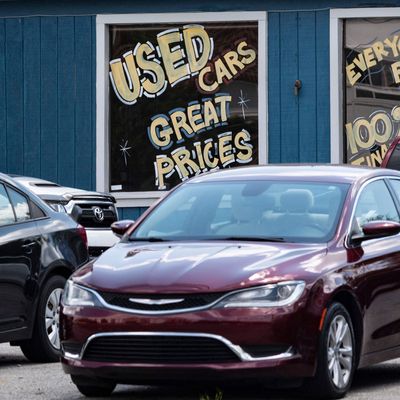
No one is dying from rising inflation, but a new report cemented it as one of the grim legacies that defined the U.S. in 2021, along with the Delta and Omicron variants of COVID-19, the attack on the Capitol, and the U.S. withdrawal from Afghanistan. On Wednesday morning, the federal government released the Consumer Price Index, its inflation report, which clocked the December rise in prices as 7 percent higher than they were a year ago, the steepest annual increase since 1982. It’s a remarkable spike for a phenomenon that wasn’t an issue at all at the start of the year, and that most — including Federal Reserve officials — believed was just a passing phenomenon as recently as this fall.
Inflation is a maddening societal problem, too big and complicated for any individual to do anything about. For the average person, the day-to-day effects of living with inflation is a gradual weakening of spending power, a feeling that the same grocery list cost more than it did last week. Zoom out and it worsens problems with inequality, eating into cash savings while stock markets soared nearly 29 percent last year — driven in part, perversely enough, by all those increasing price tags. Milton Friedman compared inflation to a “disease” whose cure was a dose of unemployment. More recently, economists like Stephanie Kelton, author of The Deficit Myth, have challenged that thinking, blaming low taxes on the wealthy, offshore manufacturing, and restrictive immigration policies as contributing to steepening prices. Still, it’s an issue without tangible causes or a clear ending, but here are five things to keep in mind about today’s inflation data — and why the worst may be over.
Don’t buy a used car right now
If you needed a car last month, you were really out of luck. The price of both new and used vehicles rose last month, but the price of pre-owned ones rose 3.5 percent, the most since June. In a quirk of accounting, car sales make up more than 7 percent of the CPI index, which was probably enough to send the CPI index to the highest level it’s been in nearly 40 years. Since semiconductor shortages continue to delay car manufacturing, this is one area that may continue to be a problem for the coming months.
Rent increases have probably peaked
The Labor Department pointed to a rise in shelter costs as one of the drivers of CPI in December. This is one of the weirder parts of the inflation picture, as the government doesn’t actually track rents, but something called owner’s equivalent rent. In a nutshell, it’s what homeowners think they would get for their space, and so it depends on their perception of the market instead of actual prices.
As Robert Armstrong in the Financial Times pointed out, the Fed’s data on the cost of rent is a bit out date. Data he cites from Apartment List shows that rents actually decreased in December, although at a smaller rate than in previous years. Since rent is harder to measure — economists have pointed out that it tends to rise slowly or not at all for long periods, and then jump when people move — the CPI survey is an imperfect measure that may have overstated the housing picture.
Omicron probably distorted the picture
Omicron started spreading in earnest in mid-December, right in the middle of the holiday buying and traveling season. Its rapid spread led to so many people calling out sick, and airlines canceling thousands of flights, that it would have had an impact on the overall economic picture. The Labor Department is silent on how it would have directly impacted prices, but the concern was that it would have caused a sudden spike in prices as supply chains took on further stress from fewer people working. The fall in transportation costs probably came directly from Omicron’s spread, but a rise in prices for things like apparel and general services also could be traced to the virus’ spread. It’s too soon to tell whether the COVID-19 variant will just be an economic blip or will still have a deeper effect on the overall economy.
The Fed will hike interest rates
The Federal Reserve has the power to raise interest rates, a very powerful tool to fight inflation. Jerome Powell, the Fed chair, has vowed to push borrowing costs up higher at a pace gradual enough for people to get used to them as a way of erasing money from the financial system. Essentially, this would divert cash away from goods and services and toward bigger interest payments, like for credit cards and loans, as a way to keep overall demand low.
This report is probably enough to give the Fed the cover it needs to start raising interest rates this March. As I wrote on Tuesday, the central bank has months of data on prices and unemployment at its hands. Barring a massive change in the national circumstances — and, after the last two years we’ve had, there’s always a chance that things can change drastically — a 7 percent rise in prices will only make it harder to justify not increasing those rates. Powell, a savvy political operator with friends in both parties, even got ahead of one of the key arguments against raising rates right now: that there are fewer people actually in the workforce than before the pandemic. He argued, without really giving evidence why, that more inflation could end up hurting the broader employment rate. For what it’s worth, even if the Fed raised rates four times this year, as economists are projecting, borrowing costs would still be at historic lows.
Prices have started to even out, or even fall
On the whole, most categories of goods and service prices didn’t rise as much as in previous months, a sign that inflation — while rising as high as it did — might be starting to wane. And when you look at the categories that tend to impact people the most, food and gas, things are starting to look better. For instance, “food at home,” the Labor Department’s category for groceries, rose 0.4 percent, down from a high of 1.2 percent in October. The Labor Department’s catchall category for transportation, which includes car sales but also public transportation, also declined to -0.3 percent.
The price of oil and gas has been one of the main drivers for the spike in prices for most of last year, with all types of energy prices rising more than 29 percent throughout the year, one of the highest-climbing categories in the CPI survey. The relentless climb was a concern as we headed into the winter months, but prices actually dropped in December, with the price of fuel oil falling 2.4 percent. The drop in prices came after the U.S. released oil reserves and oil-producing nations like Saudi Arabia and Russia agreed to produce more of the black stuff. So, while it’s still more expensive than it was a year ago, there was some relief.






























